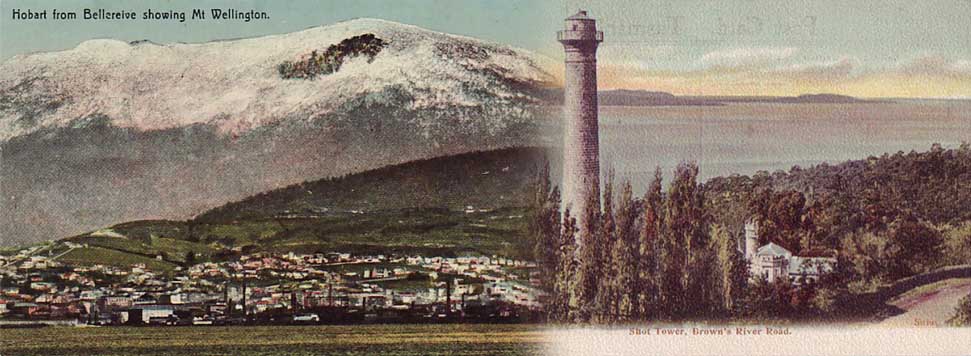Paltis Michel Koonin (b. 1883 or 1884) was a Russian political activist who lived in Australia for the period 1907–1912 and then again from 1933 until his death in 1952. He operated a photographic business in Hobart in the years 1910-1912, during which time he produced interesting and high quality photographic print postcards. The Tasmanian Museum and Tasmanian Archives hold studio photographs done by Koonin, and quite a few of his postcards are in the hands of private collectors. A number of the postcards picture carriage tour groups; it is supposed that he had an arrangement with tour operators to photograph groups along the route of their tour.
Koonin arrived in Australia in mid-1907. By March 1908 he had appeared in Melbourne as “Secretary of the Organised Unemployed” requesting assistance to stage an “agitation” in support of work for the unemployed. Later that month he took a deputation to the office of the Premier of Victoria but was ejected, causing a disturbance which was reported extensively in the press [1]. On Saturday 21 March he collided with a tram while riding a bicycle and was taken to hospital. The newspaper gave his age as 24 on that occasion.
By December 1909 he was in Hobart. The Examiner [2] reported:
“A gentleman whose card indicated that he is P.M. Koonin, BA, FZS, is just now in Hobart and his statements proclaim him to be an interesting person. He is a Russian, and by order of the Czar he was exiled to Siberia for two and a half years as a political prisoner. Mr Koonin is desirous that the people of this peaceful island of Tasmania shall know something of the terrorist activity now going on in Russia “
Later The Examiner [3] gave more detail about him;
“ Mr Koonin is touring Australasia states in pursuance of a mission he has imposed upon himself in connection with the trouble in Russia. He was arrested because he moved a resolution at a students’ meeting warning the Jewish community that a massacre was intended in Kishnioff. About six weeks after that warning the massacre took place. Subsequently Mr Koonin was sent to Siberian prisons, without trial. There he spent two and a half years and then escaped”.
The papers reported more of Koonin’s claimed background. After his escape from Siberia he spent two years in South Africa, where he claimed to have become a naturalised British subject. He claimed he held a Bachelor of Arts degree from the Hebrew University at Minak, and was a Fellow of the Zoological Society. He was described as pale, below middle height, speaking excellent English. [4]
Koonin presented lectures in Hobart, Launceston and Sydney during 1910 and 1911. His Hobart lecture titles included “Two years in Siberian dungeons as a political prisoner”, “A Message to the People”, “Siberia and the exile system”, “Red Sunday”, and “The horrors of Siberia and the Russian system in general”. They had good attendances and were extensively reported in the press. His lectures were advertised as illustrated, presumably by lantern slides.
In Hobart, Koonin registered a firm under the name of “P.M. Koonin and Company” on 8 March, 1910, giving the business as “general photography”, and the address as 70 Elizabeth Street, Hobart [6]. He was listed in the Hobart Electoral Roll, as Paltis Michel Koonin, only once, in 1914, by which time he had left the country. He may have been short of money, as in 1911 a P.M. Koonin was sued for £3 for wrongful detention of a half plate camera focusing screen. It was probably the camera he used for taking his postcards.
Koonin left Hobart by ship for South Africa on 24 April, 1912 [7], and that is the last mention of him in Australian newspapers and official records [7].
Well, that’s what I thought when I compiled the above information in 2012. Then I discovered an article by Zoe D’Arcy, of the National Archives of Australia [8]. Zoe showed that Koonin had been naturalised as an Australian in 1910. After he left Australia in 1912, he worked in London as an X-Ray dentist, not an entire career change for a man with skills in photography. He lived in Ceylon during 1928-1929 and South Africa 1931-1933, being deported from there in 1933 as an undesirable. He then came back to Australia, relying on his Australian citizenship, and took up practice as a “drugless physician” and naturopath, osteopath, dietician and psychologist. He published books in the late 1930s, under the name Dr. Paul Koonin, promoting the advantages of being a vegetarian. He died in Sydney in 1952.
[1] The Argus 18 March 1908, p. 6
[2] The Examiner 27 December, 1909, p. 8
[3] The Examiner 5 May 1911, p. 3
[4] The Examiner 5 May 1911, p. 3
[5] The Mercury 24 April 1012, p. 4
[6] The “Registration of a Firm” Certificate is in the Tasmanian State Archives
[7] Chris Long, in Tasmanian Photographers 1840-1940, lists Koonin’s period of activity in Hobart as 1910-1936, but I suspect that is based on an out of date entry carried forward in Wise’s Tasmania Post Office Directory.
[8] D’Arcy, Zoe. 2013 ‘Obviously an undesirable’: the unconventional life of Paul Koonin’ The Forgotten Times February/March 2013: 28-29
